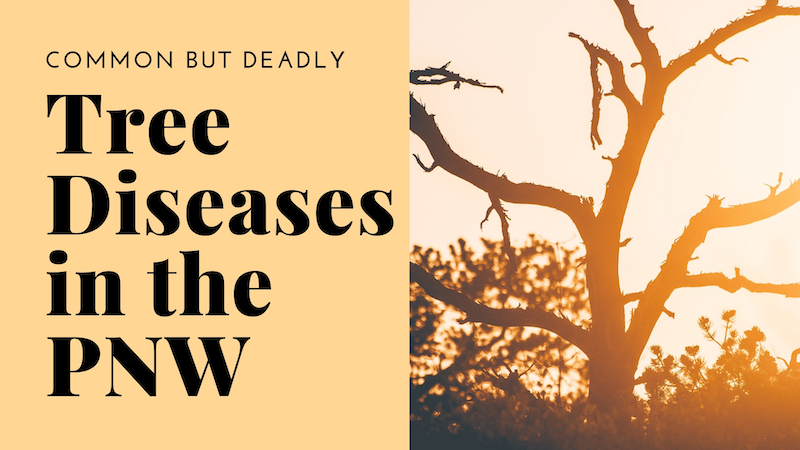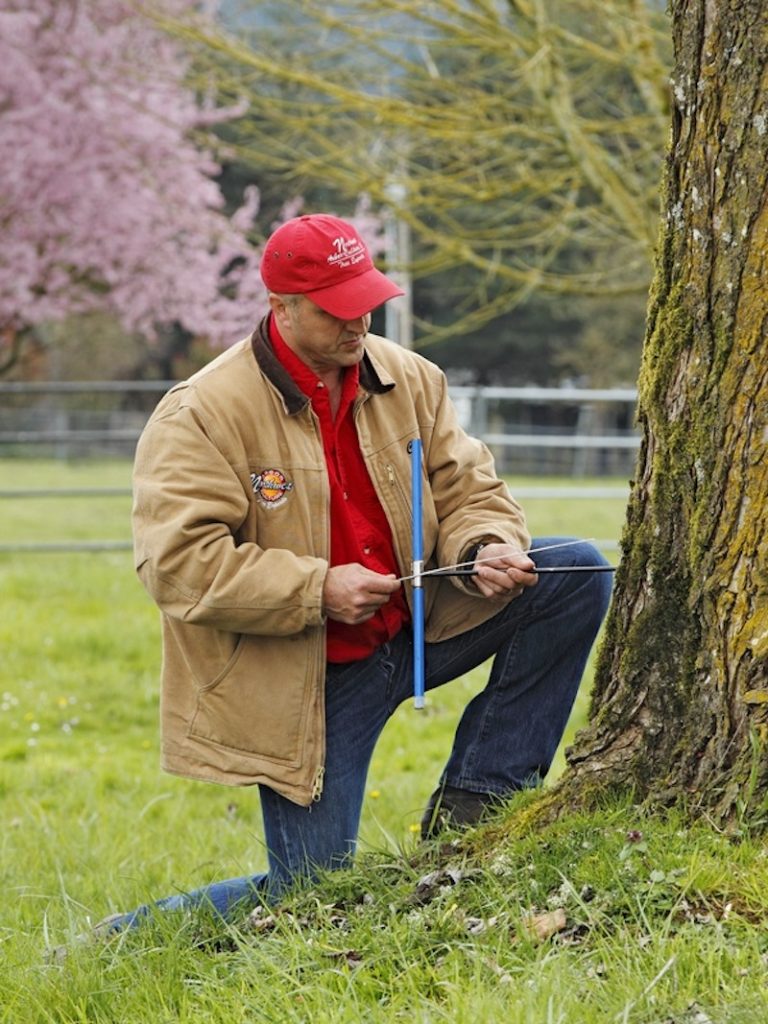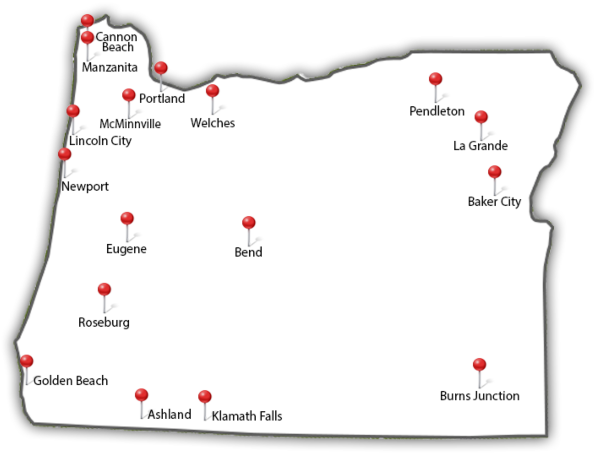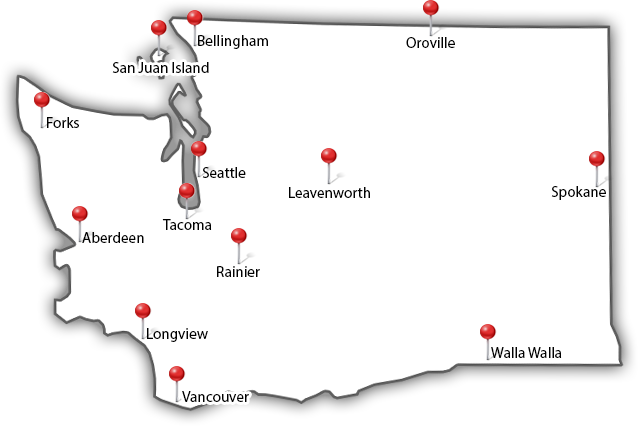4 Common but Deadly Tree Diseases to Watch for in the PNW

Portland-area homeowners need to be aware of the common diseases and fungi that affect our local trees. Left alone, an infected tree can spread the disease to other trees on your property and invite bugs and pests. Plus, they just look bad.
Whether you’ve just noticed the trees around your property are unhealthy or you want to learn how to prevent disease and issues before they start, this blog post will help.
Keep reading to learn the most common and virulent tree diseases that affect trees in the Pacific Northwest (and what you can do to protect against them).
1. Phytophthora root rot

Phytophthora root rot is caused by poor drainage or overwatering in the soil around the tree. The tree becomes unable to absorb the moisture and nourishment it needs from the soil, causing the oxygen-starved roots to slowly die and decay.
In some trees, it can take years of suffering from this disease before it dies. In others, the tree may be killed within a single season.
Types of trees affected by root rot include:
- Cherry
- Dogwood
- Holly
- Madrone
- Oak
- Arborvitae
- Cypress
- Juniper
- Port-Orford cedars
- Pines
- Firs
- Apple
- Peach
Signs and symptoms of root rot
A tree suffering from root rot will have an overall unhealthy appearance and reduced vigor. A good way to identify root rot include:
- Poor growth
- Small, pale leaves
- Wilted or yellow leaves
- A thinning canopy
- Branch dieback
To identify root rot is truly the cause of your tree’s issue, an arborist will need to examine the root tissue a few inches below the soil line. Here’s how they’ll do that:
- Carefully remove a small amount of outer bark tissue
- Examine the inner wood, looking for discoloration
- In advanced tree rot, the tree may have black, dead tissue and a foul smell
How to prevent root rot
Preventing root rot starts with good soil drainage. Avoid overwatering and creating irrigation moats to keep water from pooling against the trunk. Proper care and drainage is particularly important for young trees, as they are especially vulnerable due to underdeveloped root systems and crowns.
How to treat root rot
Since it can take years to notice root rot in a tree, by the time you notice an issue, it may be too late. However, moderately affected trees can sometimes be saved by a professional arborist, who will carefully prune out the infected roots.
If a tree is significantly infected, the best way to control the rot from spreading to other trees on your property is to remove the tree entirely.
2. Verticillium wilt

Verticillium wilt is a serious fungal disease affecting many important trees in the Pacific Northwest. This disease lives in the soil and invades trees through their roots. As it spreads through the branches, it causes the cells of the tree to “plug” themselves. The tree will eventually become so infected that water can no longer reach the leaves.
The most common tree species affected by Verticillium wilt include:
- Maple
- Ash
- Walnut
- Box elder
- Oak
- Linden
- And more
Signs and symptoms of Verticillium wilt
One common sign of Verticillium (especially in maple trees) is yellow-green streaks. This doesn’t automatically guarantee that the tree has Verticillium. A few other signs may include:
- One or more branches on one side of the tree suddenly wilt
- The leaves may appear yellow before the wilt
- A decline in new twig growth
- Increase in dead twigs and branches
- Internally, the tree may have discolored sapwood in the recent annual rings
While these are a few signs to look out for, only a professional examination can positively diagnose the disease in your tree.
How to prevent Verticillium wilt
Verticillium typically only appears in trees that are already damaged or otherwise stressed. So regular care and pruning of dead branches is recommended to maintain the tree’s overall vigor and health.
Since this and other diseases can be transmitted on pruning tools, we always recommend hiring a professional arborist that knows how to properly sterilizes tools before use.
How to treat Verticillium wilt
Unfortunately, this type of disease is incurable. Once present, it will live in the tree forever, eventually killing the tree. The good news is, with proper care from a professional arborist, you can preserve the tree and continue to enjoy it for several more years.
However, depending on the location of your tree and what types of trees and plants are nearby, it may be recommended to remove the tree and replace it with something that is not susceptible to Verticillium.
3. Anthracnose

Anthracnose is a fungal disease that infects shade trees, causing leaf spots, cupping or curling of leaves, and early leaf drop. Mild winter weather combined with wind and rain in the spring increases the presence of this disease, making Anthrancnose a very common problem here in the Portland area.
While this disease typically won’t kill a tree, it can reduce growth and it hurt the overall appearance of the tree.
The most common types of shade trees affected by Anthracnose include:
- Dogwood
- London planetree
- American sycamore
- Ash
- Oak
- Maple
- Walnut
Signs and symptoms of Anthracnose
Signs of this disease are fairly simple to catch, however the exact symptoms may manifest differently depending on the species of your tree.
The best way to notice problems is to examine the leaves of the tree. Look for…
- Brown and irregular shaped spots
- Distorted, cupped, or curled leaves
- Minor insect feeding wounds
- Leaves that are most affected on the lower and inner branches of the tree
How to prevent Anthracnose
The best way to prevent Anthracnose is to keep your tree healthy, as this will help it defend against the disease. Proper care includes providing appropriate levels of water and fertilizer, having your trees inspected every few years, and hiring a professional pruner.
How to treat
Immediately removing fallen leaves and twigs from around the tree and your yard is a great way to reduce the next year’s outbreak. You should also have a professional prune away dead twigs and branches from the crown of the tree, which will facilitate better air flow in the canopy.
In serious and repeat cases, your arborist may recommend a fungicide treatment. This treatment is typically best administered in the spring.
4. Bronze Birch Borer & Emerald Ash Borer

These two types of Beetles are very common in the PNW and can wreak havoc on your beloved birch and ash trees. The damage done by these beetles can be severe and deadly. These beetles bore into the wood of the tree and feed on its interior tissue. They will create intricate tunnels inside the tree. They also feed on the tree’s leaves and foliage.
Signs and symptoms of a beetle infestation
The first sign of infestation is typically sparse, stunted, and yellowing leaves at the tree canopy. Eventually, the branches will lose their leaves. Take a close examination of the tree’s bark and leaves and you may also find…
- Holes and splits in the bark
- New branches and leaves sprouting from the trunk of the tree or at the base
- Larvae feeding beneath the bark of the tree
- Increased woodpecker feeding
- You can often spot beetles moving around the sunny side of a tree. Bronze Birch Beetles are olive brown in color while the Emerald Ash borer is a metalix color.
How to prevent tree borers
There’s no easy way to protect your trees against these pests. Start by properly caring for your tree, including watering when it’s dry, fertilizing correctly, and booking regular tree inspections.If you have birch or ash trees on your property, you should also talk to your arborist about possible preventive chemical treatments.
How to treat a borer infestation
Once you spot symptoms of beetles, it’s usually too late to save the tree. Likely, the tree will need to be removed. Left for too long, the tree can weaken and may fall on its own, damaging your property, so don’t wait. Always seek immediate help from a professional arborist.
Does your tree look unhealthy? Schedule an inspection today

Here at Northwest Arbor-Culture Inc., we specialize in helping homeowners in the Portland and Vancouver area maintain safe, healthy, and aesthetically beautiful trees.
If you’re worried about the health of your trees, or it’s been a few years since you’ve schedule tree maintenance, give us a call at (503) 348-7642, Our ISA Certified Arborists® would be happy to take a look at your trees and also offer:
Our team of experienced arborists are here to make sure your trees stay healthy, and your home safe.
Chris Nash, Northwest Arbor-Culture Inc. from nwtree.com on Vimeo.
blog comments powered by Disqus









